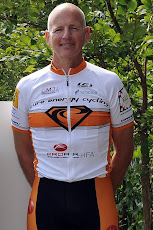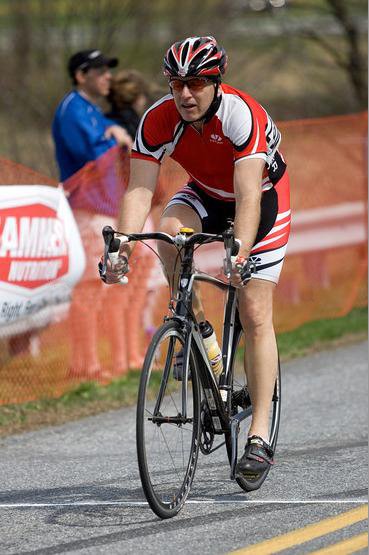Thursday, May 27, 2010
Lake Placid 2010
Good to be back. It's been a while since my last blog. I needed a vacation after my Mom's passing and a trip to Lake Placid to re-charge the batteries. What I want to do in this blog, for the benefit of the athletes that attended the recent TWiley Sports Camp in Lake Placid, NY, is to analyze my power meter file. I rode the first loop of the IMLP course with a group of riders. I did NOT necessarily ride the first loop as I would in a real Ironman bike leg but I did ride conservatively which is better than riding it hard. That is, you can always ride the 2nd loop harder. If you go out too hard on this course, I promise you that you will have not only a hard time with the 2nd loop, but also a tough time with the 26 mile run that follows. Like Coach Todd Wiley, I like to break the bike leg up into quarters: Lake Placid to Keene, Keene to Upper Jay, Upper Jay to the down/back in Wilmington, and Wilmington back to Lake Placid.
(Chart/Graph Key: Red Line= Heart Rate in bpm, Blue Line=Speed in rpm, Yellow Line= Power in watts and Orange Line= Elevation in feet.)
Lake Placid to Keene
You can see from the chart/graph that the first real climb is at the 3-mile mark. I climbed this first hill SMART..very conservative. I was averaging 220w during this climb. My Functional Threshold Power (FTP) is approx. 275w. (That's my hour power..the max power I can sustain for 1-hour.) I kept my Power (yellow line) in the Tempo range- which is good. That's where I want it. If you remember from my presentation on pacing, you want your Normalized Power to be 80% of your FTP for a 1/2 Ironman and 70% for an Ironman which is 192w. You can also see that I did NOT exceed my Lactate Threshold Heart Rate (LTHR) of 175 bpm (red line). I was averaging about 160 bpm which is in my Tempo range. So, my power and heart rate were both in the Tempo range. I could have definitely up'd the power here because of the rest on the long descent that awaited me. But, I would probably only do that on the 2nd loop if I felt strong. The high power spikes you see on the descent is where I "jumped on it". Yes, I jumped on it going downhill (which you NEVER want to do) because Rick Fesler passed me and I just couldn't let a 150 lber blow by my 175 lb fat a$$...haha. Normally, I would have pedaled at the same Tempo power (around 225w) until I spun out. i.e. ran out of gears. Then, I would have tucked in the most aero position I could and ENJOY THE RIDE. I did NOT touch the brakes at all on the descent. To slow down, I sat up. I was surprised that my max speed (blue line) was only 48 mph. I thought for sure I'd be over 50 mph. In previous years I know I exceeded 50 mph. Anyway, enjoy the descent into Keene. (Elevation profile is the orange line.)
Keene to Upper Jay
What is deceiving are the little climbs on this section of the course. They don't look like much put they can put a hurtin on you if you attack them too hard. You can see my power and heart rate both spiked on the little climbs to Threshold levels. You want to back it off a little here. Keep in the Tempo range. When the road flattens out, this is when you want to get in your aero bars and go like hell. Again, staying in the Tempo range. This section is the flatest section you're going to see on the course. It's also probably one of the fastest sections...or could be.
Upper Jay to down/back in Wilmington
I think the first two climbs after the left hand turn off of Route 9N to Highway 86E are two of the most underestimated/underrated climbs on the course. Why? Because they're the least talked about. You just don't think about them like you do the first climb out of Lake Placid of hills and you're in for a long day. It's 3 miles worth of climbing. I went too hard on both hills. Look at my HR and Power profile. Both are at or above Threshold. Well, I do have an excuse. I was trying to stay on the wheel of Coach Todd Wiley which aint very easy to do. Again, remember, keep it in the Tempo range. I did NOT do the down/back...not only because the bridge was out but because I wanted to get back to the hotel to shower and grab my camera to take photos of the 2nd loop riders. The down/back is 14 miles. My recommendation for this is to keep your speed up and let your momentum carry you halfway up the hills. The hills aren't long... but they will zap you of energy if you hit them hard or bleed off too much speed going into them.
Wilmington to Lake Placid
This 10 mile section is really NOT as hard as one might think or say it is. Yes, it's a climb but there are also flat sections, and some short descents, where you can recover. The hardest/steepest section, other than the end, is as you're passing the entrance to Whiteface Mtn. ski area. Just watch your power and HR at this point. You can see that my HR was at or near Threshold and my Power was almost FTP. Well, again, I have an excuse. I knew Coach Todd was going to try to pass my fat a$$ on the climb because I wussied out on the down/back to the detoured bridge. (Todd took the group down to the bridge that was out. I didn't join him). And, good thing I did keep the Power Up or he would have passed me.
Summary
Before I summarize the IMLP loop, lets take a look at some of the numbers/metrics on the right hand side of the graph. Lets start with Duration: 2.5 hrs. for one loop minus the down/back. Therefore, I'd say that one loop would have taken me 3 hrs. Next is Work: remember work in kJ is similar to kCal. It says I burned 1472 Calories in one loop. That's a lot. I didn't eat a thing during the first loop and just barely drank one bottle of Gatorade. Terrible example of proper nutrition there. I should have been drinking and eating (at least a Gu or two). TSS=Training Stress Score. Remember my pitch said your TSS should NOT exceed 300 for the entire 112 mile bike leg. Well, my score was 172 after only 42 miles..which definitely means I went too hard. I bet you those HARD accelerations on the descent was responsible for this number being so high. Normalized Power. It says my NP was 204w. That's the power I averaged taking into consideration not pedaling while in a draft or on a descent. Although 204w would be ok for one loop of the IMLP course it is too high if that were my average after 2 loops (112 miles). Remember, I said my 2 loop NP should be 192w average? Variability Index (VI). I didn't say much about this during my pitch except that a score of 1.3 is indicative of a hilly course like IMLP..so that number is in order. Elevation Gain. It says 2600 ft. That's really not that much. I have a 3-mile course around Bucks County that I ride that is over 3500 ft. Call me if you want to join me. Good IMLP training. Cadence. It says I averaged 78 rpm. I think that took into consideration the times where I was riding loops at 20 rpm waiting for the people in the group to catch up and soft pedaling at the start. I'm guessing I averaged more like 85 rpm. Speed. 16.4 mph average? Similarly, I think what brought the average down was the slow ride out of town..where I only averaged 12-13 mph. I think I would have averaged closer to 18.5 mph if I rode it at race pace. Temperature. How do you like that..started at 66F and ended at 82F. What a beautiful day!
In summary..not a terribly difficult course to ride. The climbs are NOT really that steep..8-10% grade max. But, if you go too hard..you WILL pay the price. You can't go wrong by sticking in the L3 Tempo Zone. If you have time to experiment on the course..go a little harder on the climbs where you can recover afterwards. See if you can get away with it. If you can, you can distance your competition. Anyway, that's what you can see/learn from a Power Meter. More information than what you can possibly imagine. All good stuff to help you pace yourself better during race day to set yourself up for a great run and a successful race.
Photos are available at the following site: http://www.pbase.com/mullerrj/lake_placid_2010
Power ON! Coach Rob
Subscribe to:
Posts (Atom)





